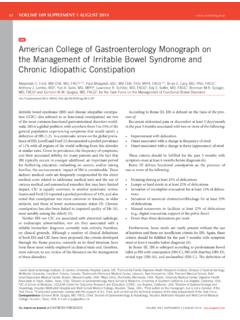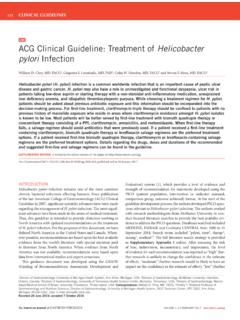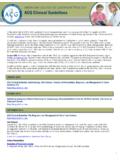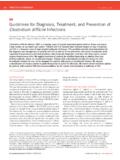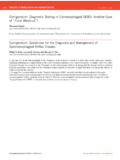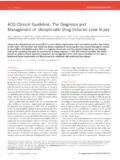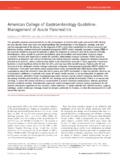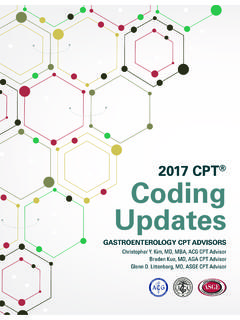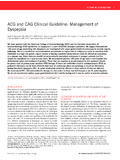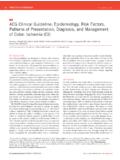Transcription of Optimizing Adequacy of Bowel Cleansing for …
1 Nature publishing group PRACTICE GUIDELINES 1. CME. Optimizing Adequacy of Bowel Cleansing for PRACTICAL GUIDELINES. Colonoscopy: Recommendations From the US. Multi-Society Task Force on Colorectal Cancer David A. Johnson1, Alan N. Barkun2, Larry B. Cohen3, Jason A. Dominitz4, Tonya Kaltenbach5, Myriam Martel2, Douglas J. Robertson6, 7, C. Richard Boland8, Frances M. Giardello9, David A. Lieberman10, Theodore R. Levin11 and Douglas K. Rex12. Am J Gastroenterol advance online publication, 16 September 2014; Colorectal cancer (CRC) is the second leading cause of cancer- provided using the Grades of Recommendation Assessment, Devel- related deaths in the United States (1). Colonoscopy can prevent opment and Evaluation (GRADE) scoring system, which weighs the CRC by the detection and removal of precancerous lesions. In addi- strength of the recommendation and the quality of the evidence (8).
2 Tion to CRC screening and surveillance, colonoscopy is used widely for the diagnostic evaluation of symptoms and other positive CRC. screening tests. Regardless of indication, the success of colonoscopy METHODS. is linked closely to the Adequacy of preprocedure Bowel Cleansing . Search Strategy Unfortunately, up to 20 25% of all colonoscopies are reported Computerized medical literature searches were conducted from to have an inadequate Bowel preparation (2,3). The reasons for January 1980 (first year of approval of polyethylene glycol electro- this range from patient-related variables such as compliance with lyte lavage solution [PEG-ELS] based preparation by the Food and preparation instructions and a variety of medical conditions that Drug Administration [FDA]) up to August 2013 using MEDLINE, make Bowel Cleansing more difficult to unit-specific factors (eg, PubMed EMBASE, Scopus, CENTRAL, and ISI Web of knowledge.)
3 Extended wait times after scheduling of colonoscopy) (4). Adverse We used a highly sensitive search strategy to identify reports of ran- consequences of ineffective Bowel preparation include lower ade- domized controlled trials (9) with a combination of medical subject noma detection rates, longer procedural time, lower cecal intu- headings adapted to each database and text words related to colo- bation rates, increased electrocautery risk, and shorter intervals noscopy and gastrointestinal agents, Bowel preparation, generic between examinations (3,5 7). name, and brand name. The complete search terms are available in Bowel preparation formulations intended for precolonoscopy Appendix A. Recursive searches and cross-referencing also were Cleansing are assessed based on their efficacy, safety, and tolerabil- performed using a similar articles function; hand searches of arti- ity.
4 Lack of specific organ toxicity is considered to be a prerequisite cles were identified after an initial search. We included all fully pub- for Bowel preparations. Between Cleansing efficacy and tolerability, lished adult human studies in English or French. however, the consequences of inadequate Cleansing suggest that A systematic review of published articles and abstracts presented at efficacy should be a higher priority than tolerability. Consequently, national meetings was performed to collect and select the evidence. the choice of a Bowel Cleansing regimen should be based on cleans- A meta-analysis and consensus agreement were used to analyze the ing efficacy first and patient tolerability second. However, efficacy evidence. Expert consensus was used to formulate the recommenda- and tolerability are closely interrelated. For example, a Cleansing tions.
5 The GRADE system was used to rate the strength of the rec- agent that is poorly tolerated and thus not fully ingested may not ommendations. The guideline was reviewed by committees of and achieve an adequate Cleansing . approved by the governing boards of the member societies of the The goals of this consensus document are to provide expert, evi- Multi-Society Task Force on Colorectal Cancer (American College dence-based recommendations for clinicians to optimize colono- of Gastroenterology, American Gastroenterological Association, scopy preparation quality and patient safety. Recommendations are and American Society of Gastrointestinal Endoscopy). 1. Eastern VA Medical School, Norfolk, Virginia, USA; 2 McGill University Health Center, McGill University, Montreal, Canada; 3 Icahn School of Medicine at Mount Sinai, New York, New York, USA; 4VA Puget Sound Health Care System and University of Washington, Seattle, Washington, USA; 5 Veterans Affairs Palo Alto, Stanford University School of Medicine, Palo Alto, California; 6VA Medical Center, USA; 7 Geisel School of Medicine at Dartmouth, White River Junction, Vermont, USA; 8 Baylor University Medical Center, Dallas, Texas, USA; 9 Johns Hopkins University School of Medicine, Baltimore, Maryland, USA; 10 Oregon Health and Science University, Portland, Oregon, USA; 11 Kaiser Permanente Medical Center, Walnut Creek, California, USA; 12 Indiana University School of Medicine, Indianapolis, Indiana, USA.
6 Correspondence: David A. Johnson, Eastern VA Medical School, Norfolk, Virginia, USA. E-mail: 2014 by the American College of Gastroenterology, American Gastroenterological Association, and the American Society for Gastrointestinal Endoscopy. This article is being published jointly in the American Journal of Gastroenterology, Gastroenterology, and Gastrointestinal Endoscopy. 2014 by the American College of Gastroenterology The American Journal of GASTROENTEROLOGY. 2 Johnson et al. EFFECT OF INADEQUATE PREPARATION ON POLYP/ preparations (fair or poor). Repeat colonoscopy within 3 years ADENOMA DETECTION AND RECOMMENDED in 216 individuals who achieved adequate preparation showed FOLLOW-UP INTERVALS an overall adenoma miss rate of 42%, and a miss rate of 27% for Recommendations lesions 10 mm or larger in size. The other study identified 373. 1. Preliminary assessment of preparation quality should be average-risk screening patients with poor or inadequate prepa- made in the rectosigmoid colon, and if the indication is ration (12).
7 Repeat colonoscopy in 133 patients (77% achieved screening or surveillance and the preparation clearly is excellent or good preparation) showed a 47% overall adenoma inadequate to allow polyp detection greater than 5 mm, the miss rate. procedure should be either terminated and rescheduled or an A single prospective Korean study evaluated 277 individuals attempt should be made at additional Bowel Cleansing strate- after a complete colonoscopy and then a per-protocol repeat tan- gies that can be delivered without cancelling the procedure dem colonoscopy within 3 months of the initial examination (13). that day (Strong recommendation, low-quality evidence). The patient adenoma miss rate increased as baseline preparation 2. If the colonoscopy is complete to cecum, and the prepara- quality decreased on the Aronchick scale. In the 19 patients with tion ultimately is deemed inadequate, then the examination poor preparation the adenoma and advanced adenoma miss rates should be repeated, generally with a more aggressive prepara- were 47% and 37%, respectively, compared with 21% and 9% in tion regimen, within 1 year; intervals shorter than 1 year are those with excellent preparation (P=.)
8 024). indicated when advanced neoplasia is detected and there is Surveys report that in the setting of a poor preparation, endoscopists'. inadequate preparation (Strong recommendation, low-quali- recommendations for follow-up evaluation vary and err on shorter ty evidence). return intervals (14,15). In 1 study 65 board-certified gastroenter- 3. If the preparation is deemed adequate and the colonoscopy is ologists and 13 gastroenterology fellows (14) were shown images of completed then the guideline recommendations for screen- preparations of excellent to intermediate quality. With a nearly per- ing or surveillance should be followed (Strong recommenda- fect preparation, a 10-year interval generally was recommended for tion, high-quality evidence). a normal screening colonoscopy. However, recommendations were quite variable for the lower-quality preparations, ranging from more Inadequate colonic preparation is associated with reduced than 5 years to an immediate repeat procedure.
9 A survey of gastro- adenoma detection rates (ADRs). A large prospective European enterologists (n=116) preparing for board certification found that study of 5832 patients enrolled in 21 centers across 11 countries 83% would recommend follow-up evaluation in 3 years or less for 1 2. examined the association of preparation quality and polyp iden- small adenomas and a suboptimal preparation (15). tification during colonoscopy performed for a range of common Several studies have examined actual recommendations indications. High-quality preparation was associated with iden- for follow-up evaluation within the framework of clinical tification of polyps of all sizes (odds ratio [OR], ; 95% con- practice. One study abstracted charts from 152 physicians in fidence interval [CI], ), and with polyps greater than 55 North Carolina practices on 125 consecutive persons in 10 mm in size (OR, ; 95% CI, ) (2).
10 An analysis of a each practice (16). Preparation quality was not reported in national endoscopic database examined the association of prepa- 32% of the examinations. Bowel preparations rated less than ration quality and polyp identification in 93,004 colonoscopies excellent were associated with more aggressive surveillance for (3). Colon preparation (as entered by the endoscopist at the time those found with no polyps or small and/or medium adeno- of the procedure) was dichotomized into adequate (excellent, mas. A prospective single-center study of 296 patients showed good, and fair/adequate) and inadequate (fair, inadequate, and that when endoscopists encountered a poor preparation they poor). In adjusted models, adequate preparation was predictive recommended follow-up intervals that more often were non- of detection of all polyps (OR, ; 95% CI, ), but not adherent with guidelines (34% nonadherent vs.)
